- Written by Emma McCauley, UX Researcher at Fathom
At the heart of design–thinking is a drive to provide valuable innovation in response to meeting real needs and solving real problems for people. In modern times, has there ever been such a vast global, national and local need for Government and public services to innovate and design for such needs and problems? The author doesn’t think so.
Right now, more than £14 billion from the ‘Coronavirus emergency response fund’ is being streamed into public services in the UK, including the NHS and local authorities. This budget is not only being spent on the front–line response, but also to develop new services and content across healthcare and the general population. Huge budgets across the globe are being spent on ‘response’ in its various guises.
As you can imagine, the need for swift, immediate and valuable services for a range of public needs and problems has already been realised at scale. This article highlights some key innovations and digital solutions that have come into citizens’ lives through design–thinking, during this unprecedented time.
1. A crisis–ready design system (NHS UK)
The GOV.UK design system, coveted globally as an exemplar of how design can scale consistently across numerous public services, has led the way again with how it was well–prepared for information management, even before Covid–19 took hold in the UK.
In 2019, the NHS adapted the GOV.UK design system and added additional elements to develop their own design system. It contains the 14 points of the GOV.UK service standard, with guidance to help teams meet them in a health context, and 3 extra points specific to health and social care.
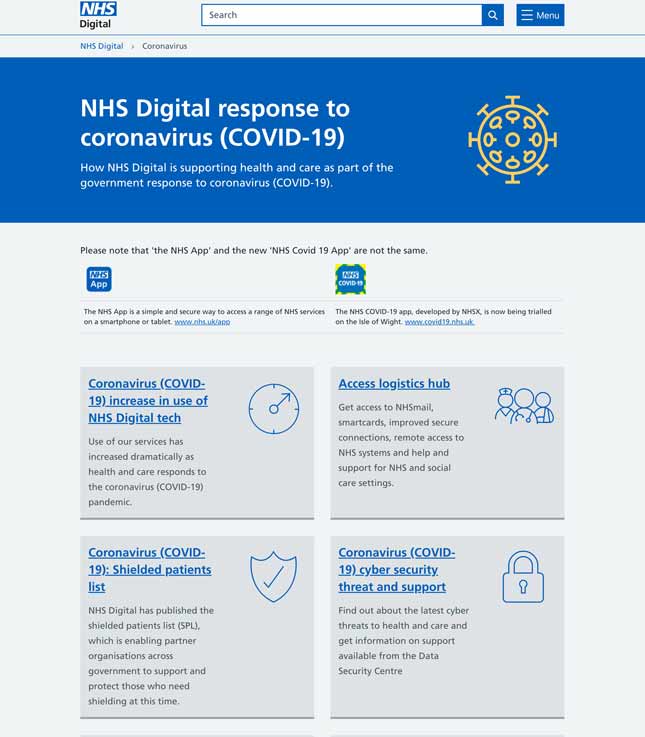
Retrieved from NHS Digital
These points include boxes that tell people if they need to get urgent help from a healthcare professional. This pattern is based on evidence that the public generally tend to scan pages, so GOV.UK made sure that if users only look at one thing on a page, it’s the info that tells them to visit their GP, or to call an ambulance. In COVID–19 times, this access to online information and its ability to influence decisions or change behaviours had these clear guidelines to work from – ensuring higher chances of success.
2. 111 – a hub for personal health management (NHS UK)
Directly related to citizen health, behaviour change and ultimately controlling the spread of Covid–19, the NHS 111 call line and online service is arguably the most important central channel to control the negative impact of Covid–19 on citizens in England.
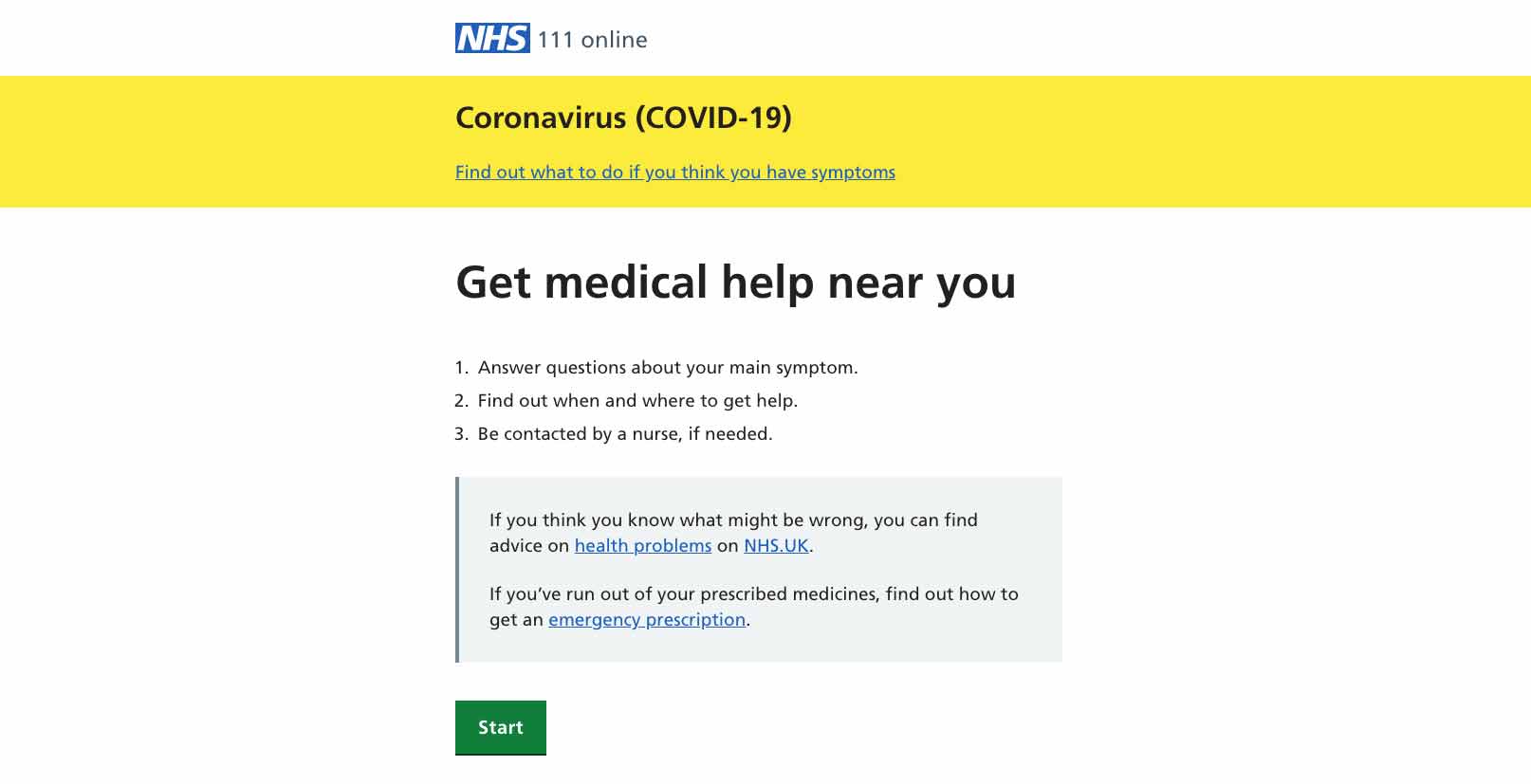
Retrieved from NHS 111
This solution has clearly been developed with significant thought and insight gained from citizens using the platform, with clear empathy shown in the content shown – especially for the most vulnerable and the elderly. In addition, as it has utilised the GOV.UK design pattern library, its use of white–space, bulleted lists, accessible forms, fonts and colours has increased its usefulness and accessibility for a wide number and range of citizens. The service is also clearly iterative, with specific feedback focussed on gaining user feedback about their experience with the virus. This information is used to plan and iterate on their response.
3. Contact Tracing app – garnering citizen feedback (NHS UK)
Contact tracing aims to identify and alert people who have come into contact with a person infected with coronavirus. It is hoped that it can be introduced towards the end of the current lockdown. The app will also let people self–diagnose if they have the illness. That means users would only have to answer an on–screen questionnaire before being judged to be at significant risk of infection.
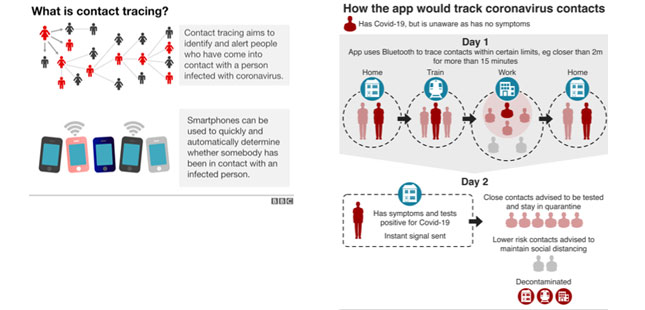
Retrieved from BBC
Proximity tracing mobile applications have previously been developed in other countries such as in Japan and France.
The application development hasn’t been without its challenges. Some concerns over privacy has led to a change to using Bluetooth rather than earlier versions using GPS location and scanning QR codes. It is hoped this in turn could encourage adoption.
In addition, low uptake is a concern – for it to be fully effective, 80% of the public must download and use the app (The University of Oxford’s Big Data Institute has modelled a city of one million people to simulate the software’s impact). If there is lower uptake, academics say the app would still help slow the spread of Covid–19.
Then there is the not–so–small issue of smartphone ownership. There have been some discussions on giving smartphones to citizens – or cheaper, wearable Bluetooth devices, in order to boost the number of citizens involved. Right now, as this article is being written a trial is ongoing on the Isle of Wight.
4. Virtual Consultations – making doctor and patient digital communication NHS compliant (NYE Health)
Beyond government led initiatives, some smaller innovation projects have seen great traction and usage, including an example of how the doctor–patient relationship can be transformed in the smartphone era. In March 2020, an entrepreneurial GP, Dr Alexander Finlayson, launched NYE Health; a way to make the clinician’s own device – whether that’s their phone, tablet or desktop web browser – “NHS–compliant”.
It means that doctors – whether in hospital or GP surgeries – can have video and audio conversations with patients or with other health workers in a secure way.
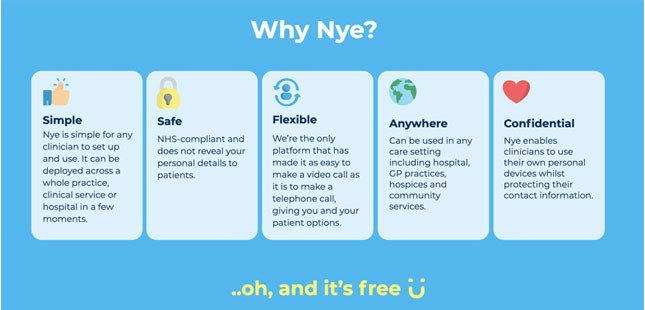
Retrieved from Nye Health
Dr. Finlayson, who has worked on global health projects in Somalia and elsewhere, says NYE had been under way as a theoretical project for a while. When confronted with the coronavirus crisis, he and a team of designers, engineers, and clinicians put the product together over an intense three–day design sprint through collaboration and design–thinking methods. It has already facilitated tens of thousands of consultations, with users everywhere from intensive therapy units to dermatology departments and GP surgeries, massively reducing time to receive a consultation.
5. Designing against misinformation (UK Government)
The UK Government has had, and very much still has, the task of communicating as clearly, accessibly and authoritatively as possible on this situation. Good communications and guidance is not an easy task, with a population of different backgrounds, beliefs, affiliations and education. Nevertheless, regardless of opinion on this, one thing all of the UK citizens must agree on is access to facts. A UK parliamentary sub–committee is taking the lead on asking members of the public to submit examples of misinformation. The committee has particularly requested the public for submissions of disinformation spread in private groups and closed apps such as WhatsApp.
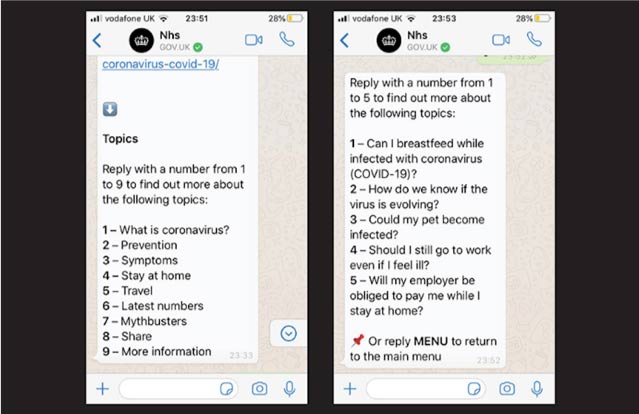
Retrieved from Little Black Book
The “Don’t Spread the Virus” campaign advises people not to share or comment on falsehoods, to avoid spreading them further. A number of other Health Ministries and NGOs around the world are also running Coronavirus health information lines on WhatsApp, including the World Health Organization, the Singapore Government, Israel’s Ministry of Health, the South Africa Department of Health and KOMINFO in Indonesia, with more services expected to launch in the coming days and weeks.
Users of the Coronavirus Information Service are able to receive easily accessible and UK–Government–verified information – to prevent the spreading of myths and misinformation. The tool will also continue to provide new content to address the evolving search queries and provide the most up–to–date information on coronavirus.
Prof Yvonne Doyle, Medical Director at Public Health England, said: “This service will help us ensure the public has a trusted source for the right information about coronavirus, updated with the latest public health guidance and providing assurance that they are not misled by any of the false information circulating.”
6. #WirVrVirus Hackathon – two days to design for good
Looking further afield to mainland Europe, there has been some great innovation in the battle against Covid–19. From Robots in Brussels care homes to the European Innovation Council’s ePitching campaign, there is so much going on – innovating for a better tomorrow and showcasing the best minds in tech, and usage of tech, for good.
Collaboration on a massive scale has been supported by the German Government #WirVsVirus. It has the record of being the world’s largest hackathon with over 40,000 participants, who have collaborated to develop projects in response to the coronavirus pandemic.
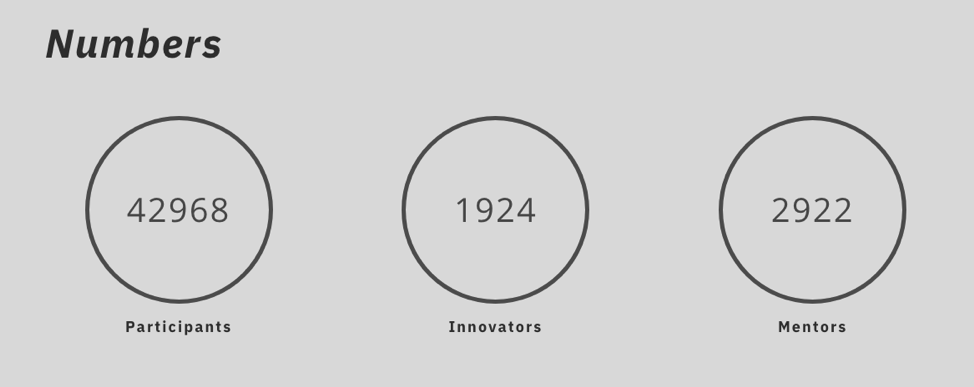
Retrieved from Wir vs Virus
It has been organising ideas, selecting, funding and quickly developing ideas into working products or services. The Hackathon, similar in format to a ‘Service – Jam’ consisted of a 48–hour format, facilitated online, using a mix of channels including Slack, video conferencing and webinars. From this, solutions were then selected by a key number of established innovation leaders. Finally, ideas were then pitched to a digital support program to ensure solutions were developed to have the greatest possible impact during the current crisis.
Some solutions selected for development that came out of the process are:
Safe test: To stop long waiting times and crowded waiting rooms with infected and non–infected people, general practitioners should book an appointment for their patients in the app. Delays and directions can also be displayed so that they can reach their appointment on time and directly.
Digital waiting room: After you have answered the questionnaire, a risk assessment should take place and the patient will be given a priority. Depending on your needs, you will receive a code for the digital waiting room and a free appointment.
Fast Border Crossing: The EU–wide platform is intended to enable hauliers to record information for a complete truck trip – from the starting country, via transit countries to the destination – in a database, which can then be checked by border officials using a QR code. In addition to information on the driver, vehicle and journey, health–relevant data can also be backed up.
In conclusion
All eyes are on government and public services right now. Meeting the needs of citizens during COVID–19 and its aftermath demands a design–thinking approach grounded in technology, boundary–breaking collaboration and innovative ways of working. To live up to citizens’ and businesses’ expectations, public service organisations need to continue to support innovation for critical solutions that are flexible and robust across crisis response, operations and long–term social and economic recovery.
This article has looked briefly at a few innovations and actions that are taking place by, or sponsored by, Government services, but it’s just the beginning. Public service innovation is a curve that we don’t want to flatten, for a better today, tomorrow and future for us all.
Cover image: Sone, D. (photographer) Doctor holding cell phone [digital image]. Retrieved from Unsplash / modified from original










